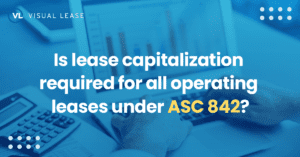
What is lease capitalization?
Lease capitalization is the act of recording Right-of-Use Assets and related lease obligations on a company’s balance sheet, as required for the lease accounting standard ASC 842.
Placing these operating lease liabilities on the balance sheet can have a significant impact on a business’ financial position – potentially affecting credit rating and debt covenants under its corporate borrowings.
What is the importance of lease capitalization under ASC 842?
With the new lease accounting standard, there is an emphasis on accuracy, comprehensiveness and transparency as to what is accounted for in a company’s balance sheet. The new lease accounting standard emphasizes accuracy, comprehensiveness and transparency of a company’s balance sheet.
It’s common for business’ stakeholders – such as a public company’s shareholders or a privately held company’s bank or private lender – to want to understand the financial health of the business they have invested in and/or provided financing.
As a result of ASC 842, a company’s audited financial statements now have a more accurate representation of the company’s overall financial health.
Which leases are under ASC 842?
Prior to ASC 842, operating leases were not captured on the balance sheet. However, under ASC 842, both operating leases and finance leases (formerly known as capital leases) need to be included on the balance sheet (in our Complete Guide to Lease Accounting, we share how operating and finance leases are capitalized and accounted for).
To identify whether a lease is classified as a finance lease or operating lease under ASC 842, check out our blog on Capital Lease Accounting for ASC 840 and ASC 842.
There are some exceptions to capitalization under ASC 842, such as the ability to not capitalize short-term leases (leases of 12 months or less). To see a further breakdown and examples, take a look at our blog on Balance Sheet Changes for ASC 842.
ASC 842 requires businesses to disclose much more detail about their lease portfolios. If your company has a high volume of leases (100 or more), and/or manages complex leases (like real estate), it is impossible to keep track of them without leveraging lease accounting software.
Leases are incredibly dynamic – changing constantly as companies renegotiate their lease terms. And each of these lease modifications needs to be examined and potentially accounted for under the new lease accounting standards. Lease capitalization has been restructured and needs to be accurately accounted for on the balance sheet – one of the many elements associated with the new lease accounting standards. It’s important to not only understand the rules but make sure your company utilizes the right software to get and stay compliant.























